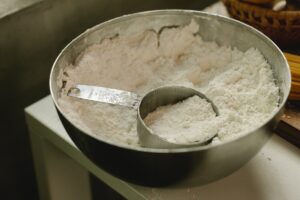Maida, also known as all-purpose flour, has been the subject of debate and controversy in recent years, gaining the nickname “white poison” from certain health professionals. This expression highlights the possible harm to one’s health that may result from ingesting goods derived from refined wheat flour. Let’s investigate the debates surrounding maida and its label as a “white poison.”

History
More than 32,000 years ago, when Italians began milling wheat to make flour, it began to exist. Using a stone-made pestle and mortar, wheat grains were roughly pounded. Attempts were made over time to refine it. Ancient Egypt attempted to refine the coarsely milled flour some 5,000 years ago. They would grind the grain first, filter it, and then separate the fine and coarse portions for this. This was how the world first Maidantered maida.
Understanding the Refinement Process of Maida
Although maida is made from wheat, the bran and germ—the wheat kernel’s nutrient-rich outer layers—are removed during the refining process. The endosperm is a starch that is pounded into a fine, white powder that is left. This procedure gives maida its distinctive look and fine texture, but it also takes away a lot of the whole wheat’s nutritious fibre, vitamins, minerals, and other essential components.
How much time does digestion require?
It can differ from person to person and relies on several variables, including each person’s metabolism, nutrition in general, and the particular cuisine made using Maida. Generally speaking, when compared to whole grains or foods with higher fibre content, refined carbohydrates like maida are absorbed rather quickly.
The body typically needs 2 to 4 hours to completely digest and absorb maida. It is important to keep in mind that digestion is a complex process and that several factors can affect how long it takes for a food to be entirely digested. A dish’s additional components, cooking techniques, and serving sizes can all affect how quickly foods containing maida are digested.
The Effect of Blood Sugar and the Glycemic Index
The high glycemic index (GI) of maida is one of the main issues with its ingestion. How quickly a food item raises blood sugar levels is measured by the glycemic index.
Due to their refined nature, foods high in maida can quickly raise blood sugar levels, followed by crashes. For people with diabetes or those who are at risk of acquiring the condition, these swings may cause increased hunger, overeating, and other possible issues.
Related: Type 2 Diabetes: How to Understand and Treat Symptoms
Must read: Sugar Cravings At Night: 18 Best Tips for Regaining Control
Sufficient dietary fibre
Dietary fibre, which is rich in whole wheat and is essential for proper digestion, blood sugar control, and producing a sensation of fullness, has several fibres. Due to the removal of this fibre content during maida’s refining process, it is less satiating and may worsen digestive problems like constipation.
Caloric Density and Nutritional Void
When compared to whole wheat, maida has a much lower nutritional profile. Its nutritional value reduces when important vitamins and minerals are removed. Additionally, maida-based products can include high levels of calories without offering the same nutritious value as entire foods. This can result in an unbalanced diet and possibly cause weight gain.
Concerns about Inflammation and Health
According to some experts, diets high in maida may contribute to chronic inflammation, which has been related to several illnesses including obesity, cardiovascular disease, and some cancers. The absence of fibre and other nutrients may contribute to the promotion of this inflammation.
Perspectives in Balance: Moderation and Choice
Despite the potential negative effects of maida, it’s crucial to remember that categorizing it as a pure “white poison” can be unduly simplistic. For many years, many societies have consumed dishes made of maida without suffering any appreciable consequences. Moderation and making thoughtful decisions are essential.
Side effects of eating maida

Due to its potential to cause vitamin deficiencies in the body, maida is not at all regarded as beneficial for human eating. It directly affects immunity, making it more challenging for the body to fend off illnesses. This is also one factor contributing to fast food consumers getting sick repeatedly.
Eating refined wheat or maida hurts brain function, claims research from Harvard University. As memory deteriorates and thinking and understanding skills decline, dementia develops. Consuming refined flour over an extended period might damage bones. The following are some Other impacts of maida,
Digestive Issues: Insufficient dietary fibre in maida, which is absent in whole grains, can cause digestive issues like constipation and irregular bowel movements.
Weight Gain: Maida-based dishes frequently contain a lot of calories and, if consumed in excess, may lead to weight gain. Due to Maida’s high glycemic index, blood sugar levels may experience quick increases and drops, which can encourage overeating.
Blood Sugar Imbalance: The speedy conversion of maida to glucose causes a sharp rise in blood sugar levels. This may aggravate the body’s reaction to insulin and possibly raise the risk of type 2 diabetes.
Nutrient Deficiency: Maida has poor nutritional value since processing strips it of many elements. Foods made of maida can cause vitamin, mineral, and fibre shortages if they are your main source of calories.
Cardiovascular Health: Regular use of foods high in maida can lead to elevated levels of triglycerides and bad cholesterol (LDL), which raises the risk of heart disease.
Inflammation: Chronic inflammation in the body is connected to several diseases, including autoimmune disorders, arthritis, and some tumours. Maida may contribute to this condition.
Disorders of the digestive system: Some people may be sensitive to or intolerant to maida, resulting in symptoms like bloating, gas, and stomach discomfort.
Dental Health: Foods with maida, particularly sugary ones, can cause cavities and tooth decay.
Reduced Satiety: Maida lacks fibre and whole grain satiety-inducing qualities, which might cause an absence of fullness and eventual overeating.
Impact on Gut Health: By altering the diversity and balance of gut flora, a diet high in maida and low in fibre can have a detrimental effect on gut health.
Allergies: Maida contains both gluten and wheat, both of which some people may be allergic to. These people may experience allergic responses after consuming dishes made with maida.
Low Nutritional Value: Meals made with maida frequently don’t have the same nutritional value as whole grains and other nutrient-rich meals, which might cause an imbalance in the diet.
FAQs
1. What exactly is maida?
Maida, commonly referred to as all-purpose flour, is a finely ground wheat flour primarily made of the endosperm of the grain. Its fine texture makes it a popular ingredient in baking and cookery.
2. What is the refining process that Maida undergoes?
The bran and germ of the wheat kernel are removed to create maida, leaving just the endosperm. Maida is created by first grinding its endosperm into a fine powder.
3. Why is maida sometimes referred to as the “white poison”?
Some people refer to maida as “white poison” to draw attention to worries about possible harmful health effects. This is brought on by the food’s high glycemic index and dearth of necessary nutrients.
4. Is maida the same as all-purpose flour?
Yes, because maida may be used in a variety of baking and cooking recipes, it is frequently referred to as all-purpose flour.
5. Are there any nutritional benefits to maida?
Maida lacks the fibre, vitamins, and minerals that are present in whole wheat flour and is largely a source of carbohydrates. Although it gives you energy, whole wheat flour is said to be healthier for you nutritionally.
6. Can maida be replaced with whole wheat flour in recipes?
In many recipes, whole wheat flour can be used in place of maida. Whole wheat flour is said to be preferable to white flour since it contains more fibre and minerals.
7. What are some alternatives to maida for those seeking healthier options?
Whole wheat flour, nut flour (almond or coconut flour), and different gluten-free flours (rice flour or chickpea flour) are healthier substitutes for maida.
8. Is it safe for people with gluten sensitivity or celiac disease to consume maida?
No, maida contains gluten, which can be dangerous for people who have celiac disease or gluten sensitivity. They ought to stay away from maida and choose gluten-free flour instead.
9. What precautions should be taken when consuming maida-based products?
Modesty is important. It is not necessarily harmful to occasionally consume foods made with maida. Still, for a balanced, nutrient-rich diet, combining them with a diet high in whole grains, fruits, vegetables, and lean proteins is crucial.
`10. Are there any specific health conditions or populations that should avoid maida altogether?
Because maida can cause significant rises in blood sugar levels, people with diabetes or those at risk of developing the disease should consume products based on it in moderation. People who have celiac disease or gluten intolerance should absolutely avoid maida.
Conclusion,
The primary reasons for contention over whether maida is a “white poison” or not are its refined form, fibre deficit, potential effects on blood sugar levels, and general health. People must consider the context of their diets, lives, and health issues when evaluating the significance of maida in their dietary decisions. It is possible to achieve a balance between enjoying culinary delights and putting health first by choosing whole grains, a variety of nutrient-dense foods, and consuming items containing plenty of maida in moderation.

